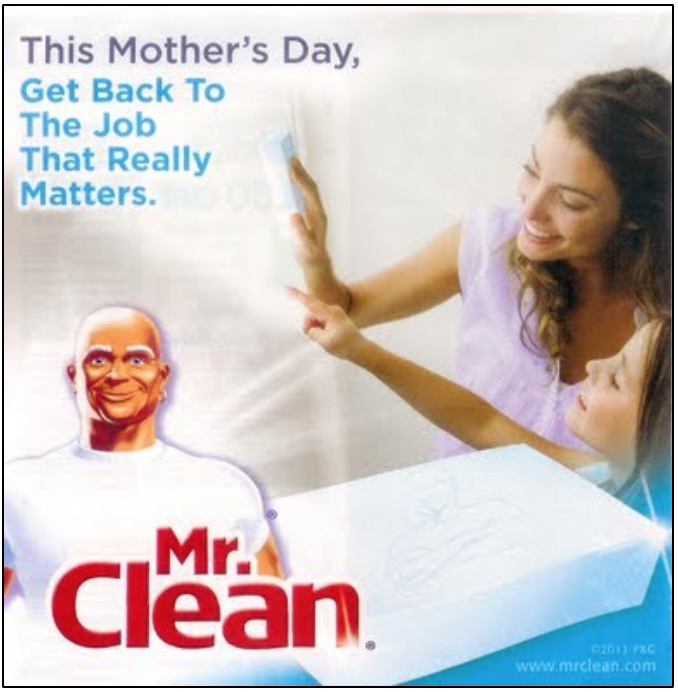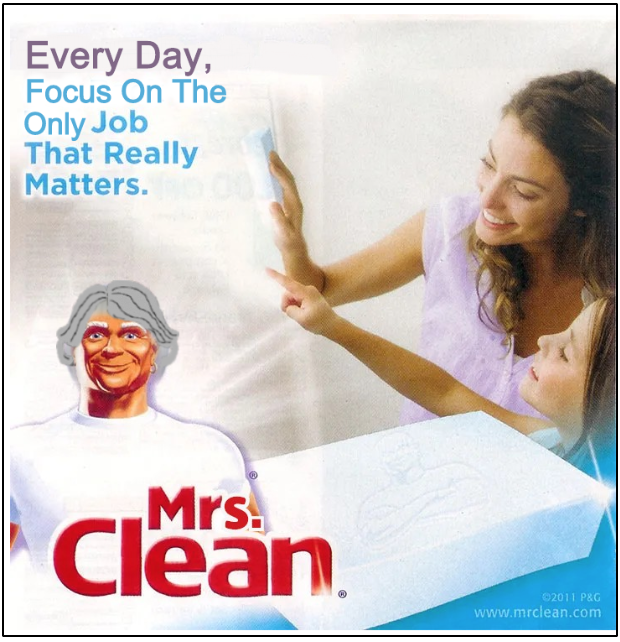
Original Ad (Bedros, 2016)
Problems with the Original Ad
It almost seems as if Mr. Clean has been advertised on TV forever and has as a result become a household product in most homes. However, the advertisements may not be as good as the product because of the underlying interpretation many of them have. Advertisements, such as the above mentioned Mr. Clean 2011 ad, continue to contain many dangerous messages. This specific ad, targeted towards females and mother’s in particular, contains gender specific assumptions.
To begin with, the advertisement’s text at the top challenges gender expectations. By writing “get back to the job that really matters”, this advertisement is associating a mother’s main role to be in charge of keeping the household clean. The advertisement is pushing how society portrays women to be the ones responsible to maintain the household, especially if you are mother, since children are known to be messy. Even on Mother’s Day, a special occasion to celebrate all mothers by taking care of them like they do us, Mr. Clean provides a reminder of what they should be doing, categorizing them as the sole maintainers of the household. Also, by writing “Mother’s Day”, this could have an underlying dangerous message implying that the Mr. Clean product is a good gift to give to a mother because they are pleased with cleaning. Moreover, using “job” in the text implies that cleaning is their main priority; just like how one’s work is a priority over other aspects in life, this ad suggests woman should make cleaning their highest priority and make sure this always taken care of, subjecting (categorizing) them to (as) a housewife.
The ad also challenges gender expectations through discrete imaging of gender. The ad shows a mother cleaning and her daughter beside her, suggesting that women should be learning how to clean from a very young age. This imagery is showcasing societies view that young women should have a willingness to take on feminine behaviours such as maintaining a household from an early age. To further drive the point, the ad shows both the mother and the daughter smiling and the daughter even pointing enthusiastically as a way to suggest they enjoy cleaning and using this product. This ad associates women with only one primary role: to take care of the household. On the other hand, men are usually associated with being able to not only take care of their families financially, but also being able to bring joy to their children (Timke and O’Barr, 2017). This message can be dangerous because females do much more than just sustain a household, as they are key contributors to all aspects of a household. Moreover, featuring the daughter in the ad sends an image that young women should find pleasure in indoor activities, whereas boys are usually seen and encouraged to go outside in advertisements.

Jammed Ad
Jamming Philosophy
In the jammed version of the 2011 Mr. Clean ad, I have made two changes that I believe better reflect the underlying messages the ad is conveying. I have changed the message written at the top of the original ad and also changed the name of the brand.
The initial message at the top of the ad was telling mothers to get back to what really matters: cleaning. This message is conveying that mothers should ignore their other responsibilities, ignore enjoying a day in their honour, and instead actively maintain the household by making sure it is sparkling clean, while also being a ‘good’ mother and teaching her daughter how to follow along in her footsteps. To highlight the dangerous social message of the ad, I have subverted the title from “This Mother’s Day, Get Back To The Job…” to “Every day, Focus On The Only Job…”. I believe this change underlines the indirect message of the ad that mothers should focus their attention solely on the household each day by treating it as their full-time job. This message reveals that mothers should be abiding by societies view of what a mother should be doing: maintaining the household and teaching their daughters to do the same.
This advertisement is tailored toward women, and mother’s specifically. Therefore, I have made the subtle change in name of the brand – from “Mr. Clean” to “Mrs. Clean”. The text in this ad is aimed toward mothers and it showcases a mother and her daughter cleaning. Although a male figure is the face of the brand, this product never aims to sell to men. Rather, it is marketed towards women and therefore I thought it was fitting to change the name to the gender it is branded towards. This ad implies an absurd message that women should be the ones to clean, and the change of name implies that if you use this product, your household will be clean and you too can be known as Mrs. Clean. With the change in the brand name, I have added a wig to Mr. Clean to alter the mascot from a man to a woman. The intended audience for this ad is women, and changing the face of the brand to that of a woman shows to potential buyers that woman have been using this product, this product works, and it is definitely the right one for you.
Although harmless at the initial glance, this 2011 Mr. Clean ad contains hazardous social messages which I hope to have revealed through my jammed version of the original ad.
References
Bedros, M. (2016, February 24). Gender Analysis of Mr. Clean Advertisement. Retrieved February 24, 2019, from https://marilinabedros.wordpress.com/2016/02/24/gender-analysis-of-mr-clean-advertisement/
Timke, E., & O’Barr, W.M. (2017). Representations of Masculinity and Femininity in Advertising. Advertising & Society Review 17(3), doi:10.1353/asr.2017.0004.